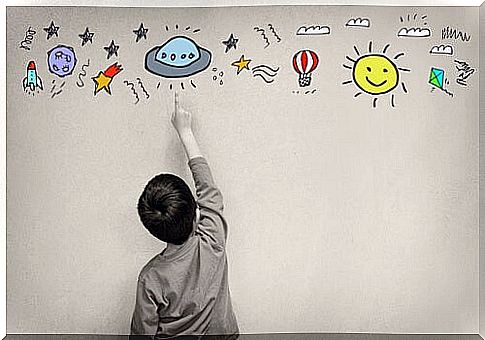7 Keys To Developing A Resilient Brain In Children

Developing a resilient brain in children is a goal that, if achieved, has enormous value. We know that our little ones are capable of extraordinary things. However, what we want most is that they are happy. For this, nothing better than teaching them to manage resources that allow them to face daily challenges, those that can arise at any time.
Few words are so fashionable. We see the term “resilience” almost anywhere, in every self-help book, in every personal development manual. Likewise, we also know that the idea it represents is not new, although it is currently when we have begun to study its effect in a more rigorous way.
Viktor Frankl has already defined its bases for us through several books. He did it by teaching us, for example, how certain people manage to cope with adversity thanks to their inner strengths, their armor, purposes and approaches.
So if these resources are so encouraging, why not pass them on to children? Doing so will involve more than just giving them simple techniques to better handle the challenges they may encounter. In reality, resilience builds in them, as in us, a new mindset. It shapes stronger brains, with greater resistance to stress and with more skilled executive functions.
The effort is worth it. Developing a resilient brain in children is possible if we follow the following strategies.

The need to “train” a resilient brain
When we face adversity what our brain experiences is stress, it is emotional anguish. Thus, this type of response begins and develops in a very specific place: in the brain amygdala.
This structure is responsible for our responses associated with fear, and it is also the one that sends messages to the brain to release adrenaline and cortisol as soon as possible. ” You have to react, you have to escape as soon as possible from that threatening stimulus!” tells us.
Now, when the amygdala, that sentinel of fear, takes over, something very characteristic happens: the prefrontal cortex loses functionality. That is, our ability to analyze the situation objectively or to reflect on the problem is completely reduced. We let ourselves be carried away by that emotional abduction dominated by fear without being able to see any way out, without having that internal calm with which to build an escape route.
If we were able to train children to have a more resilient brain, this would not happen. It wouldn’t happen at least as often. Because resilience basically involves calming the amygdala to activate the prefrontal cortex. Reduce stress to develop a more open, reflective and strong mindset. Let’s see how to get it.
1. Strong bonds and healthy attachment: be the best reference for the child
It is very possible that many think that when it comes to raising more resilient children, nothing can be better than teaching them to be autonomous and independent. Well, actually more than self-reliance what is key to developing a resilient brain is emotional connection.
Children need a healthy, strong and healthy attachment. They need people of reference who offer them love, security and protection. All of this shapes a brain that does not experience fear or stress. Because a strong brain that has not had early experiences with insecurity or fear is a brain that, in the long run, will face life’s problems with greater solvency. The absence of these traces determines a stronger, more flexible and receptive mind.
2. Train executive functions
We pointed it out at the beginning. Our goal is to calm the amygdala (fear) and train the prefrontal cortex (executive functions). In this way, we will offer the child resources to be able to solve problems, focus attention and be creative when challenges arise, be they big or small. All of this will prevent you from being trapped in fear, in anguish.
These are the strategies to develop executive functions in children:
- Establish routines
- Model healthy social behaviors.
- Promote social connection with trustworthy people.
- Opportunities to establish your own connections with your peers (camps, sports …)
- Creative games.
- Memory games.
- Creative games.
- Opportunities for them to make their own decisions.

3. Practice mindfulness
Another great way to build a resilient brain in children is mindfulness. Being able to connect with the here and now in a relaxed way improves brain connection, relieves stress and enhances executive functions. If we introduce this practice into their lives early, we will see great benefits.
4. Convey to children the idea that they are competent and capable
A child must be perceived as competent in their day-to-day life. As someone capable of learning from their mistakes to improve, someone who can improve every day to handle new skills and abilities with greater solvency. That feeling, that of having our support and recognition, will allow you to make better decisions little by little.
5. Convey optimism to develop a resilient brain in children
Realistic optimism can be a great help to them. Let us show them that any reality that may contain problematic nuances can be posed in terms of personal improvement. This will be where its true value lies.

6. Face your fears with support: asking for help is good
To develop a resilient brain in children it is necessary that we help them manage negative valence emotions, such as fear. The first thing we can give you is an idea: asking for help is not only recommended, but also necessary. In addition, those who ask for help are brave enough to recognize their vulnerability, their needs, and make way for deeper relationships.
Helping others and allowing oneself to be helped is a dynamic that children must establish early in their lives. In this way, the fears will become smaller, they will lose power over them until they disappear.
7. Learn to build a “problem solving box”
This tip is as fun as it is useful. From the age of 5 a child is already capable of learning to solve simple problems.
If we give them a “problem kit” for their day-to-day life and show them how to use it, we will be helping them to mature. As they grow, they will be the ones who perfect the use of these tools and adapt them to their circumstances.
Thus, that problem-solving box can be filled with the following strategies.
What to do when something worries me:
- Consult with mom and dad.
- Ask someone you trust for help or advice.
- If I have had this problem before think about how I solved it. Can I do better now?
- Understand that every problem, no matter how big, can be broken down into smaller pieces to solve it.

In conclusion. Training, shaping and fostering a resilient brain in children requires upbringing based on a secure attachment and where, in turn, we offer a solid foundation in terms of strategies to cope and solve problems.
We are talking about a type of active and creative education, where the adult serves as a reference. Something like this determines a great responsibility on our part: We are referring to an adventure that will always be worthwhile.









